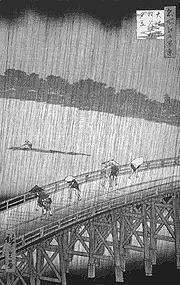| back to: Chapter 6 
Sudden Shower on Ohashi Bridge
Ando Hiroshige
color wood block print
c. 1857 (Japanese)

The Prophet
Emil Nolde
Woodcut (print)
1912 (German Expressionist)
Printmaking methods in depth
|
Chapter 6: Printmaking
Relief
- WOODCUT
Woodcut is the process of cutting away parts of the surface of a wood block and then inking the remaining surface. The image is then transferred to paper using a press or other pressure. Emil Nolde's image The Prophet is a good example of a woodcut that shows the grain of the block. Hiroshige's Sudden Shower on Ohashi Bridge shows careful attention to detail and the woodblock is not evident.
- WOOD ENGRAVING
is different from woodcut because a laminated wood surface is employed instead of a raw wood board.
- LINOCUT
is a common method of printmaking that employes a soft rubbery material called linoleum. These types of printmaking blocks can be found in art supply and craft stores.
Intaglio
- ENGRAVING
is a process that involves making clean cuts into a metal plate. When inked and wiped clean the residual ink (now down in the cut grooves) remains and is printed by pressing paper onto the surface with enough pressure to lift the ink from the grooves.
- DRYPOINT
is a process that involves marring the surface of a metal plate so that ink will slip into the burrs created by a sharp metal tool. The print is made by wiping the excess ink from the plate, then using paper to pull the leftover ink from under the burrs. This type of printmaking has a limited life because the burrs will eventually be pushed down in the process of printing.
- ETCHING
is a printmaking method that involves the use of acid to marr the surface of a metal plate. The plate is prepared with an acid-resistant substance (like wax or asphaltum) then the artist scratches through the resist to bare the plate. When the image has been set, the plate is placed in an acid bath (usually nitric acid) wherein the bared metal areas will be corroded away by the acid. After the plate is cleaned, the plate is inked, wiped clean and printed. Rembrandt was an excellent practioner of etching. In the 100 Guilder Print, Rembrandt uses this process to create an image that could be reproduced in a large quantity.
- MEZZOTINT and AQUATINT
are processes that involve marring the entire plate. Mezzotint uses a tool that creates burrs all over the plate which the atists later burnishes down to create the white areas. Aquatint involves using a resinous powder to mask the plate and utilizes an acid bath to control the image.
Lithography
is a planographic printing process. The process uses water/oil resist to control where ink will appear on a surface. Originally, the process involved using a slab of limestone. This particular limestone is a water-loving or hydrophilic material. An image could be drawn on the surface with an oily crayon, etched with a nitric acid solution, then cleaned with kerosene. The clean stone would the be rewetted, inked (at this point the ink will only adhere to the areas where the oily crayon had been used) and printed. Honore Daumier was an excellent lithographer. His work Rue Transonian was published in the Parisian newspapers in the 19th Century.
Serigraphy
also referred to as silk screen printing. The arttist creates a stencil on a special screen then pushes the ink through the screen (usually with a squeegee) onto a surface.
Monotype
is a printmaking method wherein the artist creates an image on a surface by using ink like paint on a surface, then printing the surface. This process yeilds only one print for each surface preparation.
Chapter 8
| |
|
